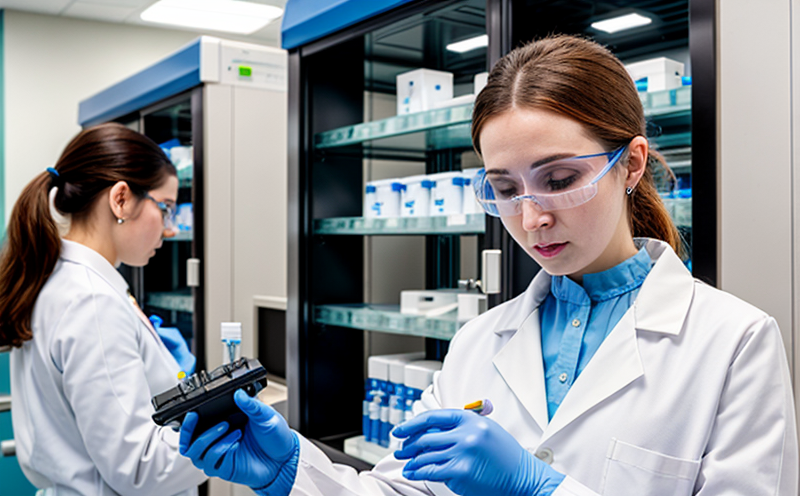Bioanalytical Testing
In the pharmaceutical sector, bioanalytical testing is a critical component that ensures drug safety and efficacy. This service focuses on quantifying active pharmaceutical ingredients (APIs), metabolites, and other biomarkers in biological matrices such as blood, plasma, urine, and tissue samples. The goal of these tests is to provide data that supports the development, manufacturing, and regulatory compliance of new drugs.
Bioanalytical testing involves a combination of advanced analytical techniques designed to measure minute quantities of substances within complex biological fluids. These methods are highly sensitive and precise, allowing for accurate quantification even when dealing with trace amounts of compounds. The process typically begins with the collection of biological samples from volunteers or patients undergoing clinical trials.
The instruments used in bioanalytical testing include liquid chromatography-tandem mass spectrometry (LC-MS/MS), ultra-performance liquid chromatography (UPLC), and gas chromatography-mass spectrometry (GC-MS). These technologies are chosen based on their ability to separate, detect, and quantify the target analytes in various matrices. The choice of instrument also depends on factors like sample complexity, desired sensitivity, and selectivity.
To ensure accurate results, the laboratory adheres strictly to international standards such as ISO 17025 for quality management systems and ICH Q3D (Guideline for Elemental Contaminants in Drug Substances and Products) for elemental impurities. Compliance with these guidelines is essential for maintaining credibility and trust within the pharmaceutical industry.
The primary challenge in bioanalytical testing lies in handling biological matrices which are inherently complex due to their high variability. Factors like matrix effects, interfering substances, and sample stability can significantly impact test results. To address this, the lab employs robust quality control measures including method validation studies, inter-laboratory comparisons, and ongoing calibration checks.
Bioanalytical testing plays a pivotal role in various stages of drug development:
- Discovery Phase: Identifying potential new drugs through early-stage screening and profiling of biological samples.
- Clinical Trials: Monitoring the pharmacokinetics and pharmacodynamics of investigational drugs to ensure they meet therapeutic goals.
- Manufacturing: Ensuring consistent quality and purity of APIs during production processes.
- Regulatory Compliance: Providing data necessary for approval by regulatory authorities like the FDA or EMA.
The accuracy and reliability of bioanalytical tests are paramount, as they directly influence patient safety and drug efficacy. By leveraging cutting-edge technology and adhering to stringent quality standards, this service ensures that only the highest-quality pharmaceutical products reach the market.
Scope and Methodology
Bioanalytical testing encompasses a wide range of analytical techniques tailored to the unique challenges posed by biological samples. The scope includes quantification of APIs, metabolites, and other biomarkers in various matrices such as blood, plasma, urine, and tissue. This service employs advanced methods like LC-MS/MS, UPLC, and GC-MS to achieve high sensitivity and precision.
The methodology involves several key steps:
- Sample Collection: Carefully collected biological samples are sent for analysis. Proper handling and storage conditions are crucial to maintain sample integrity.
- Preparation: Samples undergo preliminary processing such as extraction, dilution, or derivatization to prepare them for analysis.
- Analytical Analysis: The prepared samples are analyzed using LC-MS/MS, UPLC, or GC-MS. These instruments provide detailed information about the presence and concentration of target analytes.
- Data Interpretation: Analysts interpret raw data to derive meaningful insights into drug behavior within biological systems.
The use of multiple analytical techniques ensures comprehensive coverage of potential contaminants and biomarkers, enhancing both accuracy and reliability. The lab continuously validates methods according to ICH Q3D standards to ensure robustness and reproducibility.
Method validation is a critical aspect of bioanalytical testing. It involves demonstrating that the method performs consistently across different laboratories and operators. This process includes defining limits of detection (LOD) and quantitation (LOQ), establishing linear ranges, and assessing precision and accuracy through intra- and inter-laboratory studies.
Inter-laboratory comparisons are conducted regularly to ensure consistency in results obtained from different facilities. These exercises provide valuable feedback on method performance and help identify areas for improvement.
Customer Impact and Satisfaction
- Informed Decision-Making: Accurate bioanalytical data enables stakeholders to make informed decisions regarding drug development, manufacturing processes, and regulatory submissions.
- Enhanced Safety: By identifying potential safety risks early in the process, this service helps ensure that only safe drugs enter clinical trials and reach patients.
- Cost Efficiency: Early detection of issues through bioanalytical testing can prevent costly rework or delays in drug development timelines.
- Regulatory Compliance: Meeting stringent regulatory requirements enhances the credibility of pharmaceutical products, facilitating smoother approval processes.
The lab has a strong track record of delivering reliable and accurate results, which is reflected in high customer satisfaction levels. Regular feedback from clients indicates that they value the depth of knowledge provided alongside the technical expertise offered by the team.
Customer testimonials highlight how this service has contributed to successful drug development projects and improved overall product quality. Clients appreciate the proactive approach taken by the lab towards identifying potential issues and offering solutions early in the process.
Use Cases and Application Examples
Bioanalytical testing finds application across multiple stages of drug development:
- New Drug Discovery: Identifying potential new drugs by profiling biological samples.
- Clinical Trials: Monitoring the pharmacokinetics and pharmacodynamics of investigational drugs to ensure they meet therapeutic goals.
- Manufacturing: Ensuring consistent quality and purity of APIs during production processes.
- Regulatory Compliance: Providing data necessary for approval by regulatory authorities like the FDA or EMA.
In a recent case study, a biotech company used bioanalytical testing to assess the pharmacokinetics of an experimental drug candidate. The results provided critical insights into how the compound behaved within the body, helping guide further development efforts. Another example involves a large pharmaceutical corporation which relied on this service during their FDA submission for a new antiviral medication.
These real-world applications underscore the importance of bioanalytical testing in ensuring drug safety and efficacy. By providing comprehensive data, this service plays an essential role in advancing medical treatments and improving patient outcomes.





